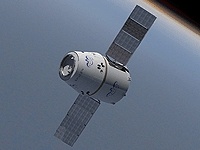After orbiting the earth at speeds greater than 17,000mph, the Dragon spacecraft re-entered the Earth’s atmosphere and landed in the Pacific Ocean.

The Dragon spacecraft is comprised of three main elements: a nose cone (which protects the vessel and the docking adaptor during ascent), a spacecraft (which can house cargo) and a trunk (which provides for the stowage of unpressurised cargo, solar arrays and thermal radiators).
During the flight, many systems on the Dragon were tested for the first time in space. These included its structural integrity, precision firing of the 18 spacecraft’s own SpaceX Draco engines, telemetry, guidance, navigation and control systems, the heat shield and its parachutes.
The landing of the spacecraft marks the first time a commercial company has successfully recovered a spacecraft re-entering from low-Earth orbit. It is a feat performed by only six nations or government agencies: the US, Russia, China, Japan, India and the European Space Agency.
It is also the first flight under NASA’s COTS programme to develop commercial supply services to the International Space Station (ISS).
In December 2008, NASA announced that it had selected SpaceX’s Falcon launch vehicle and Dragon spacecraft to resupply the ISS when the Space Shuttle retires.
The $1.6bn (£1bn) contract represents a minimum of 12 flights as part of the commercial resupply services contract for NASA, with an option to order additional missions for a cumulative total contract value of up to $3.1bn.
Founded in 2002, SpaceX is a private company owned by management and employees, with minority investments from Founders Fund, Draper Fisher Jurvetson and Valor Equity Partners.





Glasgow trial explores AR cues for autonomous road safety
They've ploughed into a few vulnerable road users in the past. Making that less likely will make it spectacularly easy to stop the traffic for...